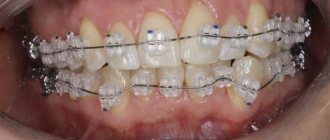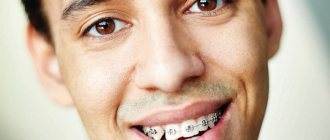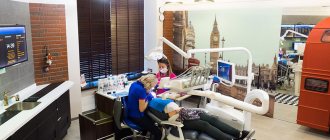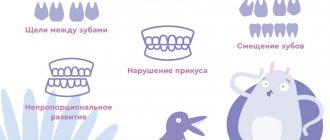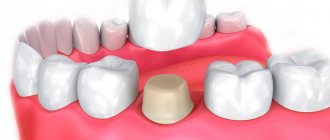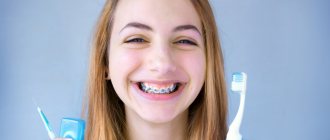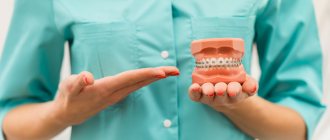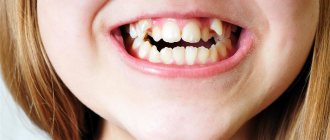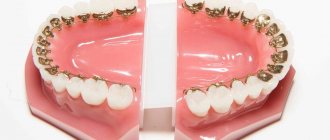This question may well arise if just one tooth spoils a beautiful smile, protruding from a slender dentition. That is, is it possible to use only one bracket to eliminate this aesthetic problem, and not the entire structure, which is usually installed on a full row of teeth?
After all, this will allow you to significantly save on dental treatment. In order to get an answer to this completely reasonable question, you need to understand the working mechanisms and design of the brace system.
Features of treatment
Malocclusion is a pathology of the jaw or teeth, characterized by a violation of their development and growth.
Installing a braces system is a classic method of correcting existing defects, which consists of attaching a structure to the teeth that puts pressure on the teeth in order to move them into the correct position. Experts recommend installing braces on both jaws for simultaneous and uniform correction of pathology. However, if there are no anomalies in the lower jaw or the patient does not have the financial capabilities to carry out complex treatment, it is possible to install braces on the upper jaw without exposing the lower dentition to the structure.
A-Medic Clinic provides comprehensive and partial treatment with braces. All features of correction depend on the characteristics of the pathology. To determine the most suitable and effective braces model, an individual approach is taken to each patient.
How to install the structure
Before using braces, you may need dental treatment for caries and other oral pathologies. After the orthodontic system is manufactured, it is installed on the teeth prepared for this. It happens like this:
- A bracket (clasp) is attached to each tooth and is fixed using a special adhesive composition.
- Each bracket is connected to the next archwire.
The features of this design make it possible to create a directed pressure of a certain force specifically on the curved teeth, which over time displaces or turns them in a given direction. The installation procedure does not cause any pain.
The duration of use of local braces depends on the type of pathology, its severity and the age characteristics of the patient, but most often it does not exceed ten months. Fragmentary braces can be placed on children when the baby incisors have been replaced by permanent ones, as well as when all the chewing teeth have grown, which is important for the quality of the system installation. That is, this is possible at the age of 8-10 years.
Indications for partial correction
Malocclusion has a number of negative consequences, but the reason patients turn to an orthodontist in most cases is the unaesthetic appearance of their teeth and smile. In addition to aesthetics, malocclusion pathologies lead to speech defects, frequent dental diseases and gastrointestinal problems. Treatment is recommended in adolescence, but the defect can be corrected in adult patients.
Indications for installing braces on the upper jaw:
- curvature of several teeth, which does not lead to deviation in the closure of two jaws;
- deviation in the location of the dentition of individual teeth;
- the growth of one (several) teeth outside the dentition (in this case, the units are not superfluous);
- trema and diastema no more than 3 mm;
- slight degree of twisting of individual units;
- re-correction for mild forms of pathology.
In rare cases, experts recommend fixing the system on only one jaw, since in the future consequences may arise that require repeated, but complex, correction.
Consider treatment with Botox injections
In severe cases, botulinum toxin injections into the masticatory muscles can be used to reduce the manifestations of bruxism. After administration of the drug, the muscles partially relax and the spasm is relieved. This is followed by relief from headaches, toothaches and other unpleasant symptoms. Botulinum toxin lasts up to 6–8 months, then the muscles regain sensitivity and the ability to contract. This should be enough time to stop grinding your teeth.
There is no way to get rid of bruxism once and for all. But with an integrated approach, you can get a good result: reducing the load on the temporomandibular joints, restoring enamel, and improving the quality of sleep.
Contraindications
Installation of braces, regardless of the place of their attachment, is carried out only in the absence of concomitant dental diseases (pulpitis, caries, periodontal disease, etc.). Before the correction begins, the patient undergoes treatment and professional cleaning. These indications are relative limitations that can be eliminated before the main occlusion therapy is carried out.
Absolute contraindications to installing braces only on the upper dentition:
- severe form of bite pathology;
- deviation in the closure of the jaws or individual teeth (molars or canines);
- severe curvature of teeth;
- torsion with a distance between units greater than 1 mm;
- The gap between two adjacent teeth is more than 3 mm.
It is not recommended to put braces on people with mental illness, immunodeficiency, endocrine and cardiovascular systems, or oncology. In case of contraindications, A-Medic clinic specialists select another method for eliminating malocclusions.
Consequences of malocclusion
First of all, defects affect the patient’s self-confidence and problems arise from an aesthetic point of view. Also, incorrect position of teeth relative to each other can cause poor oral hygiene, which will cause plaque and food particles to accumulate in hard-to-reach places. As a result, more serious diseases may develop, such as caries or tissue inflammation.
The most dangerous consequences in the absence of timely medical intervention include the following: strong breath, loss of one or more row units, severe bleeding, pain and sensitivity, reaction to cold or hot food, and much more.
What are the causes of malocclusion? As a rule, this problem is hereditary in nature or its cause lies in early childhood. Risk factors include constant thumb sucking in infancy, the use of pacifiers and bottles, especially those with an anatomically shaped nipple. It is very important to show your child to the dentist before the age of 5, until the bite is completely formed and can be easily corrected.
Types of braces for the upper jaw
For minor dental defects in the upper jaw, treatment can be carried out with mouthguards, aligners or braces. The possibility of a more gentle effect on the dental composition is assessed by a specialist.
If the installation of braces is indicated, then after diagnostics and consultation, the orthodontist determines which design will be more effective and offers the patient several options for system models.
You can install ligature or non-ligature braces on the upper jaw. The difference between the models is that the first ones have locks or rubber bands on each plate to secure the arc, while the second ones do not. Orthodontists recommend a ligature-free system because it is more comfortable and does not require regular visits to a specialist to change the tension of the arch.
Clinic A-Medic offers a large selection of models from different manufacturers, made of various materials. The designs are made of metal, plastic, ceramic and sapphire. Considering that the upper teeth are visible when smiling, it is advisable to install ceramic or sapphire braces, as they look more aesthetically pleasing. But in case of complex pathologies, preference is given to a metal structure, which is considered more effective.
Lingual models deserve special attention. These are structures that are fixed on the inside of the teeth. Those placed outside are called vestibular. Lingual braces for the upper jaw can be made of metal, since they are completely invisible to others and are an ideal option for aesthetics. However, the price for lingual braces for the upper jaw is quite high, even if only one structure is fixed.
Material for manufacturing orthodontic systems
The choice of material for orthodontic structures is quite wide:
- metal;
- plastic;
- ceramics;
- dental sapphire.
Metal ones are the cheapest. Metal braces look scary, but they are one of the best in terms of treatment effectiveness. The metal does not stain when worn, does not bend or break.
Patients try to choose inconspicuous structures made of plastic/ceramics/sapphire for the upper jaw. However, everything has its own characteristics. For example, plastic braces begin to turn yellow over time and may not withstand the load - they break. Such designs can be worn for no more than six months with a slight curvature of the row.
Ceramics are more resistant to stress compared to plastic. Ceramic braces can be almost invisible if the color of the material is matched to the tone of the enamel. Sapphire braces are made from a special crystal grown under certain conditions. Such hardware structures are not inferior in strength to metal ones and are not noticeable. The whole issue is the high price.
Correction process
You can install braces on the upper jaw at the best price at the A-Medic clinic. Our specialists have many years of experience in bite correction and regularly undergo training in innovative techniques.
Treatment of malocclusion pathologies begins with a consultation with an orthodontist. You can make an appointment with a specialist at the clinic directly on the dentist’s website or by phone. After consultation, the patient undergoes diagnostics, treatment (if indicated) and a preparatory procedure (professional cleaning).
After the preparatory stages are completed, the patient visits the orthodontist’s office to take impressions from which the structure will be made.
At the next appointment, the braces system is installed. The doctor glues the plates, passes the arc, tightens and fixes it. Throughout the treatment, which can last up to 1.5 years, the patient periodically visits the doctor to monitor the processes of correction of defects in the upper dentition.
How long should you wear partial braces?
In adults, the period of use of partial corrective structures ranges from 6 months to 10 months; for a child, it can last for two years until all permanent teeth appear. For the effectiveness of treatment and timely adjustments when wearing partial braces, it is necessary to visit the orthodontist once a month. If you ignore this rule, you may end up not getting the effect of wearing braces: money and time will be wasted.
Before installing partial braces, the condition of the teeth and gums must be in perfect order: all dental diseases have been cured and hygienic cleaning has been carried out. Any braces systems are installed only in a healthy oral cavity.
Is it worth installing one system?
Installing braces on the upper jaw at an affordable price in Moscow is an advantageous offer that allows you to save money on bite treatment. But experts do not advise making the decision to correct only one jaw on your own. This method of eliminating bite defects is permissible only if the orthodontist confirms the absence of serious violations in the upper row and the need for correction of the lower jaw.
If the patient, despite the advice of a specialist, wants to install only one corrective system, then the doctor warns about the possible consequences. Most patients have problems closing their jaws after removing braces. Thus, even greater deformation occurs, requiring repeated, but complex treatment with a dual system.
What dental problems can braces solve?
Correction systems allow you to solve several dental problems at once:
- correct malocclusion;
- prevent the displacement of teeth adjacent to the removed one;
- align abnormally growing permanent teeth;
- cope with some congenital disorders of the upper and lower jaws.
Braces allow you to straighten crowded or, conversely, too sparsely spaced teeth. How does the structure work and how is the dental row corrected?
Cost of braces
If there are indications for installing the system on both jaws and there is a lack of financial resources, you can choose a model at a lower cost, or take advantage of the clinic’s offer “Braces in installments/credit.” If the orthodontist recommends installing the structure only on the upper jaw, then you can safely save money without fear of consequences.
Correct bite means a beautiful smile, healthy teeth and the absence of a number of problems that arise from bite defects. A-Medic Clinic offers to correct the consequences of damage or congenital pathology by installing braces. You can find out how much braces for the upper jaw cost on the dentist’s website, in the center itself, or from the clinic’s consultants.
The A-Medic clinic often holds promotions offering treatment with braces at a discount. You can find out about the best offers in the “Promotions” section. We also recommend that you learn more about the possibility of receiving the service in installments in the section “Braces in installments.”
Removable braces: pros and cons
Mouthguards, plates, trainers have a list of undeniable advantages. They also have some disadvantages. Let's list both.
Pros of removable devices:
- The tight fit to the teeth and transparent material ensure that the product is invisible to others.
- The patient quickly gets used to the device and does not feel discomfort or pain during the treatment process. The correction occurs gradually, in a gentle manner.
- Hygienic procedures are easy to carry out , since the patient can independently remove the structure from the mouth without any problems.
- It is possible to correct a schoolchild’s bite when the dentofacial apparatus is still developing.
- A person wears a removable system for only 11-15 hours/day, which allows him to go out into public places without it.
- With the help of such devices, you can wean your child off bad habits that can negatively affect the bite.
- The products are suitable for children who refuse to wear traditional permanent braces.
- Aligners, orthodontic caps and trainers help to fix the result obtained during treatment with conventional braces. They prevent teeth from returning to their original incorrect position.
One of the disadvantages is the inability to treat serious deviations in the structure of the dentofacial apparatus. In addition, these devices are not always suitable for adults. They are most often used for children.
Hygiene recommendations
Orthodontic structures require more careful and careful hygiene, since it is possible for food debris to get stuck between the individual elements of the structure. To do this, it is recommended to use special brushes and brushes that make cleaning easier, as well as an irrigator that helps to quickly and efficiently clean hard-to-reach places. During treatment, follow-up with a periodontist and regular professional oral hygiene are recommended to prevent gum inflammation and the development of dental caries.
Can aligners replace braces?
Many people consider aligners as an alternative to braces, but this is not entirely true. Both systems differ from each other in the principles of tooth movement, speed of movement and duration of wear. Therefore, initially it is impossible to call aligners an analogue of braces. My opinion, as an expert in orthodontics, “what is better for the patient – braces or aligners” is the following: at the diagnostic stage, the patient does not need to think about the choice, it is necessary to thoroughly understand the current situation with the bite. And only then formulate the most effective solution.
Are aligners more effective than braces?
Can aligners replace braces? Not at all. Perhaps, at first glance, the version about the super effectiveness of aligners may seem true to a non-specialist. But this is only at first glance. Yes, progress does not stand still, and every year aligners begin to solve more and more complex bite problems. This is good news. And perhaps in 10 years, aligners will be able to cover more than 95% of bite pathologies that they can correct. But there will still be another 5 percent of violations that will only be possible with braces.
